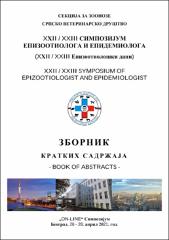| dc.contributor.author | Grubač, Siniša | |
| dc.contributor.author | Mirčeta, Jovan | |
| dc.contributor.author | Žekić Stošić, Marina | |
| dc.contributor.author | Pajić, Marko | |
| dc.contributor.author | Knežević, Slobodan | |
| dc.contributor.author | Pušić, Ivan | |
| dc.date.accessioned | 2021-06-24T07:39:25Z | |
| dc.date.available | 2021-06-24T07:39:25Z | |
| dc.date.issued | 2021-04-26 | |
| dc.identifier.isbn | 978-86-83115-41-9 | |
| dc.identifier.uri | https://repo.niv.ns.ac.rs/xmlui/handle/123456789/371 | |
| dc.description.abstract | Disinfection procedure represent an important component in preventing the spreading of contagious disease African swine fever (ASF). Indeed, disinfection is a process that everyone knows, but there are frequently insufficient practical knowledge about how to apply and effectiveness. It has been confirmed that disinfectants may be completely ineffective on surfaces that contain large amounts of organic matter of different origin. On the other hand, ASF virus is characterised by the high external environmental resistance, especially in the presence of organic matter (blood, feces, litter etc.). The problem is also the biofim that is created on the surfaces, which represents a community of microorganisms that are irreversibly connected to the surface. Having in mind the above facts, the selection and application of disinfectants when it comes to combating ASF is not easy decision. The aim of this research is to present the disinfection procedure in the ASF infected area i.e. in the backyards domestic swine population where the presence of the ASF virus has been confirmed. There are no indications in literature regarding the ideal disinfectant against ASF virus, but every country has approved a list of biocides effective against this virus and thus only authorised biocides should be used and applied according to the producer’s instructions. Cleaning and washing represents one of the most important steps before disinfection. It removes over 90% of microorganisms when properly performed and improves the disinfection efficacy. Disinfectants that are known as effective against ASF virus are: 2% sodium hydroxide solution, 2% Vircon S, 2% Oxicid S, glutaraldechide during 10-30 minutes depending on the ambient temperature. The evaluation of disinfection success can be performed by taking swabs from different types of surfaces before and after disinfection. According to our research, the field disinfection had good results when was done on hard, smooth concrete and rubber surfaces, previously well cleaned and degreased with foamers. The weakest results were on surfaces contaminated with different organic matter. | en_US |
| dc.description.sponsorship | This work was funded by Ministry of Education, Science and Technological development of Republic of Serbia by the Contract of implementation and financing of scientific research work of NIV-NS in 2021, Contract No: 451-03-9/2021-14/200031 | en_US |
| dc.language.iso | other | en_US |
| dc.publisher | SVD, Sekcija za zoonoze, Beograd (Srbija) | en_US |
| dc.source | Zbornik kratkih sadržaja, XXII/XXIII Simpozijum epizootiologa i epidemiologa (XXII/XXIII Epizootiološki dani), on-line, Beograd | sr |
| dc.subject | disinfection | en_US |
| dc.subject | African swine fever | en_US |
| dc.subject | control | en_US |
| dc.subject | suppression | en_US |
| dc.title | Dezinfekcija kao značajna mera u kontroli i suzbijanju afričke kuge svinja | en_US |
| dc.title.alternative | isinfection as an important measure in the control and supression of african swine fever | en_US |
| dc.title.alternative | | en_US |
| dc.type | Article | en_US |

